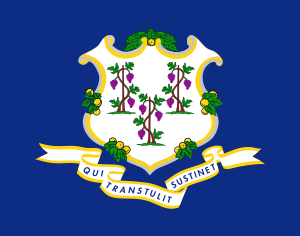Connecticut (Georgian Escalation)
Connecticut was one of the original thirteen United States and part of New England. It traces its history to a Puritan settlement founded in 1636. Connecticut grew as an early center of American shipping and industry. As the New York City metro area sprawled out in all directions, it came to include much of southwestern Connecticut. The state was one of the most densely-populated in the nation.
History
Pre-Judgment Day
The advent of lend-lease in support of Britain helped lift Connecticut from the Great Depression, with the state a major production center for weaponry and supplies used in World War II. Connecticut manufactured 4.1% of total U.S. military armaments produced during the war, ranking ninth among the 48 states, with major factories including Colt for firearms, Pratt & Whitney for aircraft engines, Chance Vought for fighter planes, Hamilton Standard for propellers, and Electric Boat for submarines and PT boats. In Bridgeport, General Electric produced a significant new weapon to combat tanks: the bazooka.
On May 13, 1940, Igor Sikorsky made an untethered flight of the first practical helicopter. The helicopter saw limited use in World War II, but future military production made Sikorsky Aircraft's Stratford plant Connecticut's largest single manufacturing site by the start of the 21st century.
Connecticut lost some wartime factories following the end of hostilities, but the state shared in a general post-war expansion that included the construction of highways and resulting in middle-class growth in suburban areas.
Prescott Bush represented Connecticut in the U.S. Senate from 1952 to 1963; his son George H. W. Bush and grandson George W. Bush both became presidents of the United States. In 1965, Connecticut ratified its current constitution, replacing the document that had served since 1818.
In 1968, commercial operation began for the Connecticut Yankee Nuclear Power Plant in Haddam; in 1970, the Millstone Nuclear Power Station began operations in Waterford. In 1974, Connecticut elected Democratic Governor Ella T. Grasso, who became the first woman in any state to be elected governor without being the wife or widow of a previous governor.
Connecticut's dependence on the defense industry posed an economic challenge at the end of the Cold War. The resulting budget crisis helped elect Lowell Weicker as governor on a third-party ticket in 1990. Weicker's remedy was a state income tax which proved effective in balancing the budget, but only for the short-term. He did not run for a second term, in part because of this politically unpopular move.
In 1992, initial construction was completed on Foxwoods Casino at the Mashantucket Pequots reservation in eastern Connecticut, which became the largest casino in the Western Hemisphere. Mohegan Sun followed four years later.
In 2000, presidential candidate Al Gore chose Senator Joe Lieberman as his running mate, marking the first time that a major party presidential ticket included someone of the Jewish faith. Gore and Lieberman fell five votes short of George W. Bush and Dick Cheney in the Electoral College. In the terrorist attacks of September 11, 2001, 65 state residents were killed, mostly Fairfield County residents who were working in the World Trade Center. In 2004, Republican Governor John G. Rowland resigned during a corruption investigation, later pleading guilty to federal charges.
During and After Judgement Day
Because of its proximity to New York City, a massive population center for America, Connecticut was mostly bombed, except for New Haven.
During the remainder of 2008, 2009, 2010 and pretty much 2011, the area was in a lawless ruin with criminals fighting criminals. Finally, on August 4, 2012, Yale University became a state, followed by New London. Both nations had cordinal ties, and united on December 22, 2030.
Survivor States
As of 2035, the following nations have been identified:
- Most, if not all of Connecticut, is under the control of the Kingdom of New Connecticut, a mix of the Yale Kingdom and the New London Republic.
